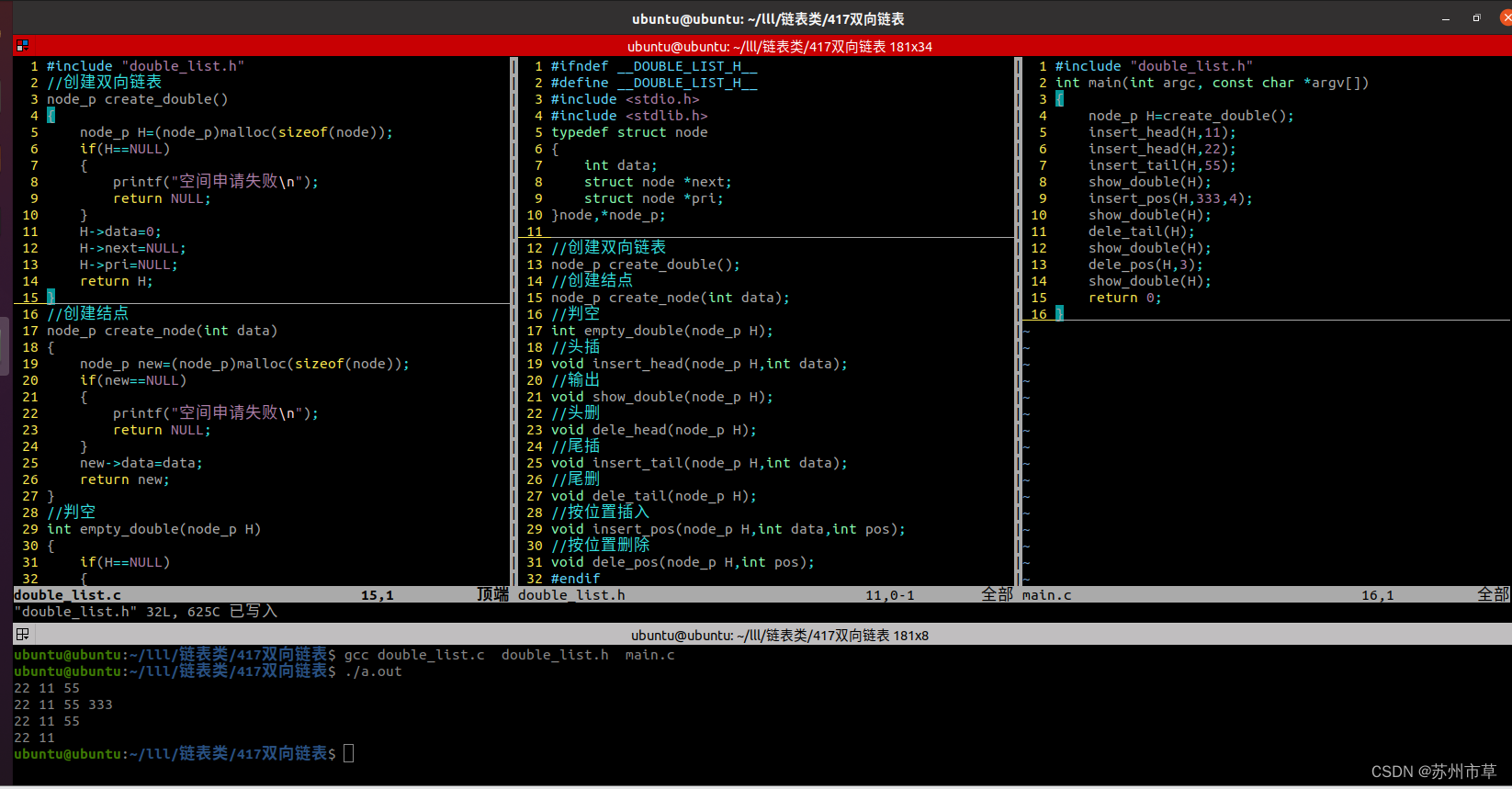1.双向链表的头插、头删、尾插、尾删、按位置插入、按位置删除
#include "double_list.h"
int main(int argc, const char *argv[])
{
node_p H=create_double();
insert_head(H,11);
insert_head(H,22);
insert_tail(H,55);
show_double(H);
insert_pos(H,333,4);
show_double(H);
dele_tail(H);
show_double(H);
dele_pos(H,3);
show_double(H);
return 0;
}
#ifndef __DOUBLE_LIST_H__
#define __DOUBLE_LIST_H__
#include <stdio.h>
#include <stdlib.h>
typedef struct node
{
int data;
struct node *next;
struct node *pri;
}node,*node_p;
//创建双向链表
node_p create_double();
//创建结点
node_p create_node(int data);
//判空
int empty_double(node_p H);
//头插
void insert_head(node_p H,int data);
//输出
void show_double(node_p H);
//头删
void dele_head(node_p H);
//尾插
void insert_tail(node_p H,int data);
//尾删
void dele_tail(node_p H);
//按位置插入
void insert_pos(node_p H,int data,int pos);
//按位置删除
void dele_pos(node_p H,int pos);
#endif
#include "double_list.h"
//创建双向链表
node_p create_double()
{
node_p H=(node_p)malloc(sizeof(node));
if(H==NULL)
{
printf("空间申请失败\n");
return NULL;
}
H->data=0;
H->next=NULL;
H->pri=NULL;
return H;
}
//创建结点
node_p create_node(int data)
{
node_p new=(node_p)malloc(sizeof(node));
if(new==NULL)
{
printf("空间申请失败\n");
return NULL;
}
new->data=data;
return new;
}
//判空
int empty_double(node_p H)
{
if(H==NULL)
{
printf("入参为空\n");
return -1;
}
return H->next==NULL?1:0;
}
//头插
void insert_head(node_p H,int data)
{
if(H==NULL)
{
printf("入参为空\n");
return;
}
node_p new=create_node(data);
new->next=H->next;
if(H->next!=NULL)
{
H->next->pri=new;
}
new->pri=H;
H->next=new;
H->data++;
}
//输出
void show_double(node_p H)
{
if(H==NULL)
{
printf("入参为空\n");
return;
}
if(empty_double(H))
{
printf("链表为空\n");
}
node_p p=H->next;
while(p!=NULL)
{
printf("%d ",p->data);
p=p->next;
}
putchar(10);
}
//头删
void dele_head(node_p H)
{
if(H==NULL)
{
printf("入参为空\n");
return;
}
if(empty_double(H))
{
printf("链表为空\n");
}
node_p p=H->next;
if(H->next->next!=NULL)
{
H->next->next->pri=H;
}
H->next=H->next->next;
free(p);
}
//尾插
void insert_tail(node_p H,int data)
{
if(H==NULL)
{
printf("入参为空\n");
return;
}
node_p p=H;
while(p->next!=NULL)
{
p=p->next;
}
node_p new=create_node(data);
new->next=p->next;
p->next=new;
new->pri=p;
H->data++;
}
//尾删
void dele_tail(node_p H)
{
if(H==NULL)
{
printf("入参为空\n");
return;
}
if(empty_double(H))
{
printf("链表为空\n");
}
node_p p=H;
while(p->next->next!=NULL)
{
p=p->next;
}
node_p temp=p->next;
p->next=NULL;
free(temp);
}
//按位置插入
void insert_pos(node_p H,int data,int pos)
{
if(H==NULL)
{
printf("入参为空\n");
return;
}
if(pos<=0||pos>H->data+1)
{
printf("位置不合理\n");
return;
}
node_p p=H;
for(int i=0;i<pos-1;i++)
{
p=p->next;
}
node_p new=create_node(data);
new->next=p->next;
if(p->next!=NULL)
{
p->next->pri=new;
}
new->pri=p;
p->next=new;
H->data++;
}
//按位置删除
void dele_pos(node_p H,int pos)
{
if(H==NULL)
{
printf("入参为空\n");
return;
}
if(empty_double(H))
{
printf("链表为空\n");
return;
}
if(pos<=0||pos>H->data)
{
printf("位置不合理\n");
return;
}
node_p p=H;
for(int i=0;i<pos-1;i++)
{
p=p->next;
}
node_p temp=p->next;
if(p->next->next!=NULL)
{
p->next->next->pri=p;
}
p->next=p->next->next;
free(temp);
H->data--;
}

2.总结链表和顺序表的区别
顺序表适用于数据元素较少、读取操作频繁的场景;
链表适用于数据元素较多、插入、删除操作频繁的场景。





















 573
573











 被折叠的 条评论
为什么被折叠?
被折叠的 条评论
为什么被折叠?








